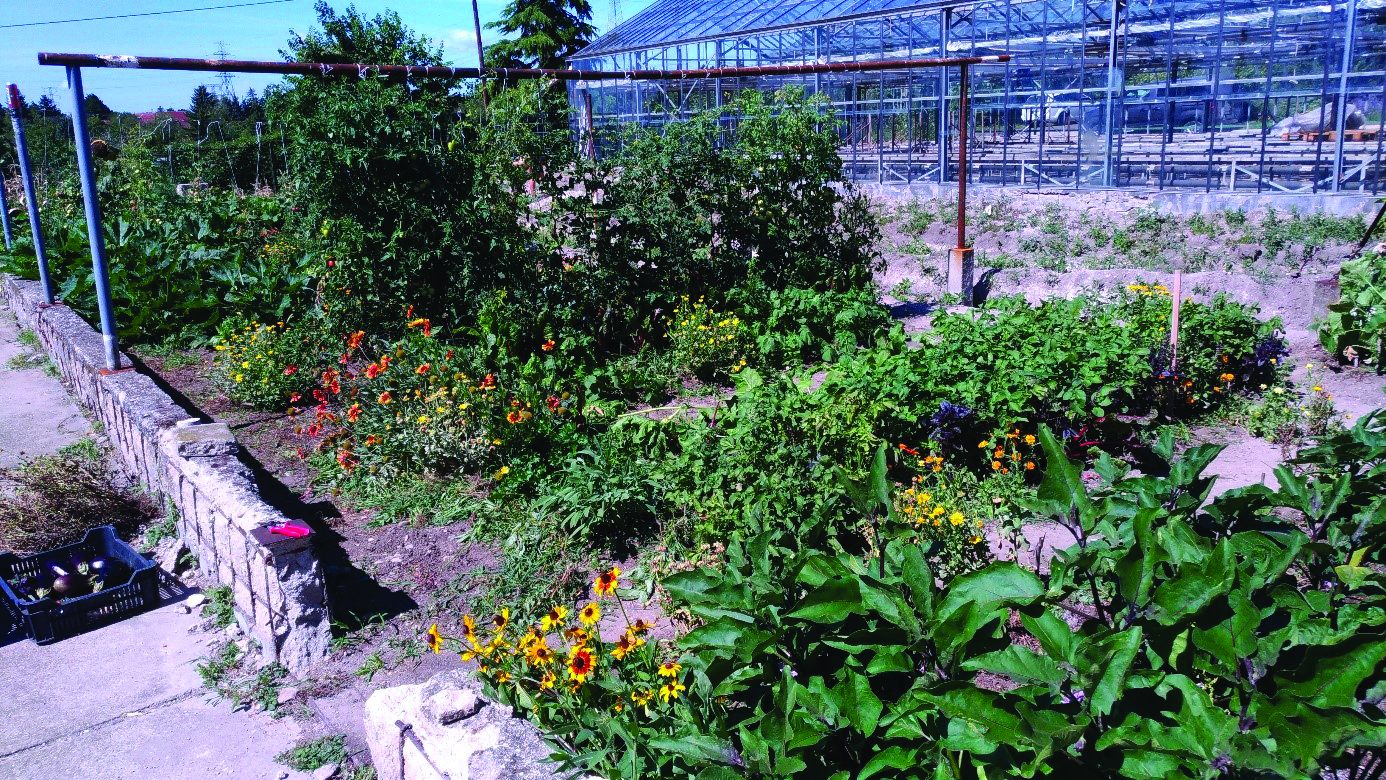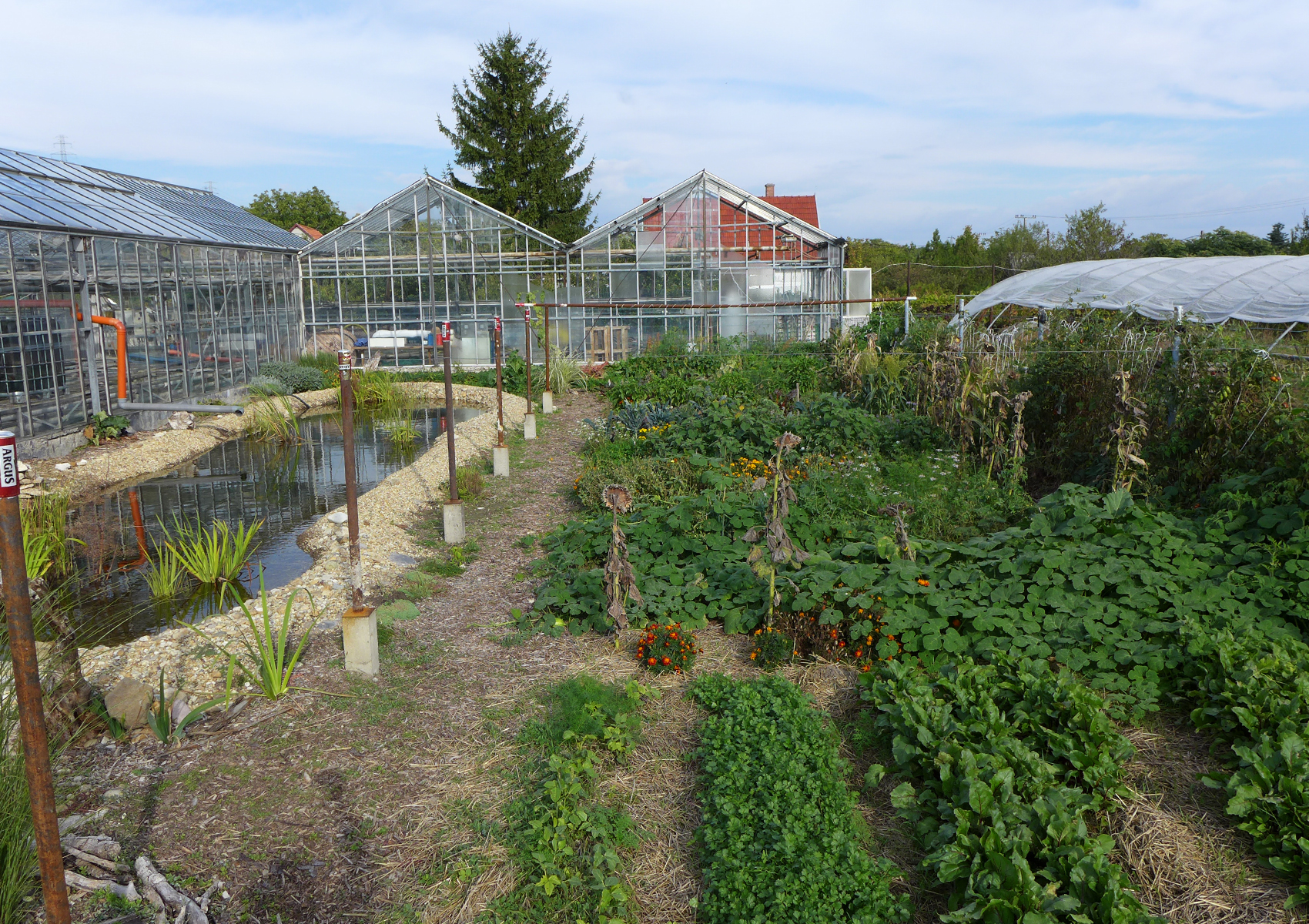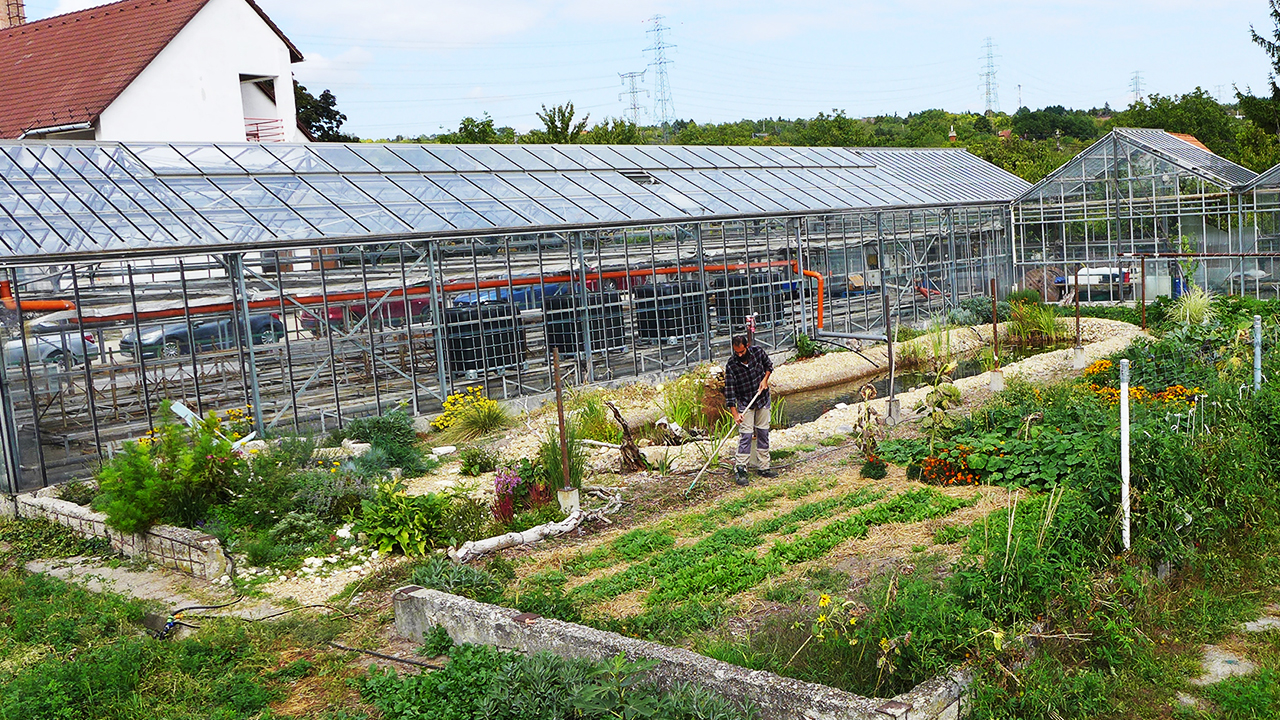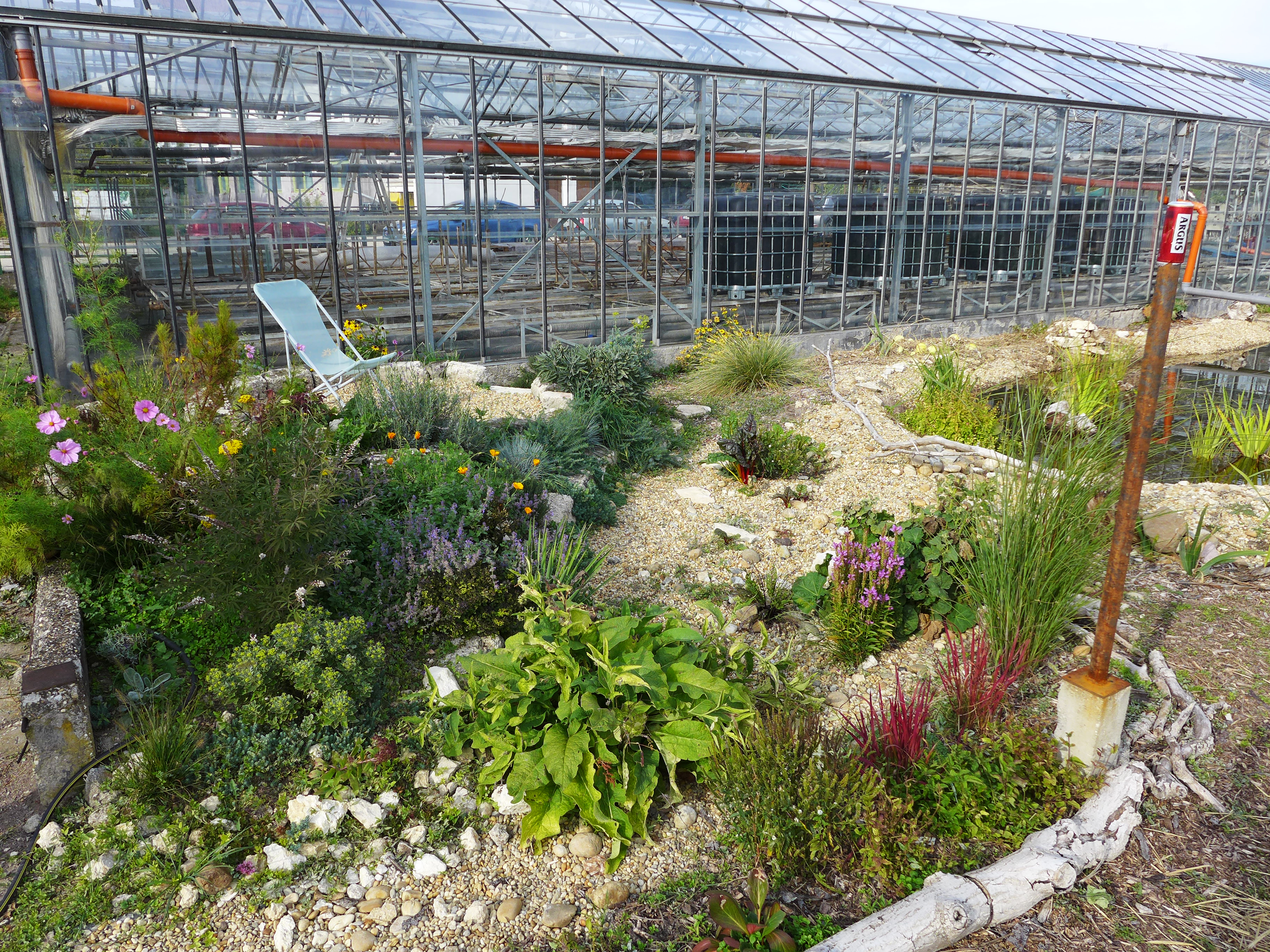What has an office building in the capital got to do with permaculture? Or office workers with planting, composting, rainwater harvesting, or the roots of a goat's beard? Nothing and everything. Grapoila Permaculture is a unique initiative in Hungary to revitalize a neglected, desertified area around an office building in a permaculture approach. The area thus regenerates faster, provides food, serves as a resting area, and as an ever-changing educational base due to the seasonality.
Grapoila, our company is situated in Hungary and produces zero-waste cold-pressed oils, gluten-free seed flours, seed creams, pet food supplements, and natural cosmetics. We have done everything in our power to produce sustainably and to minimize our environmental impact. We find it necessary to form an active attitude - that goes far beyond the life and operation of a company - towards protecting the environment and trying to sensitize society about sustainability. Our main target audience is people, especially young people, who have lost direct connection with nature while living in an urban environment but are looking for a way to do chemical-free, sustainable farming in full symbiosis with nature. This intention guided us when, in the spring of 2020, we embarked on a project that is unique in Hungary: we have created a permaculture garden as a demonstration project around our office building in Budapest. The philosophy of permaculture is perfectly intertwined with everything we represent and we want to show and pass on to others. Our main principle of thinking about the environment and the attitude that seeks solutions and encourages lasting deeds is to know, respect, and love nature.
Our project is inspired by Kertmagyarország Mozaglom, a movement that urged the creation of quality farming in Hungary, which could have been a path of social uplift for the peasantry. It also advocated the re-naturalization of the forgotten Hungarian animal and plant varieties and agricultural methods.
So far, we’re past two seasons that have provided a wealth of experience and ideas to continue.
Please highlight how the project can be exemplary in this context
For us, sustainability means developing systems that produce enough energy over their lifetime to maintain and replace themselves, generating more energy and value for their environment, than taking. We focused on this aspect during the design of our permaculture garden, for example, it is perfectly maintainable with very minimal or no use of fossil fuels. Our key objectives in this project were:
- The most important goal was to regenerate the ecosystem of the area, in a way that there is an established energy circulation between its various elements (food circulation: garden goods - human - leftovers - composting - garden; earthworm compost - fed to fishes - fish manure - garden; earthworm compost - chicken - chicken manure - fruit trees; water circulation: capturing - irrigating - transpiration and evaporation; seedling cycle: seedlings - selling - investing in the greenhouse and the garden).
- Another key objective is education. We want to teach the public about simple, chemical-free gardening methods, recommend recipes made out of seasonal fruits and vegetables - even wild plants -, and generally overthrow environmentally harmful agricultural dogmas. This is why we started organizing various workshops at our garden about permaculture-related topics.
Please highlight how the project can be exemplary in this context
When designing the position of the various elements of the garden, one of our goals was to give them as many different functions as possible - of which one was the aesthetic function. For example, the small lake not only serves as a water catchment area, but it also reflects sunlight onto the glasshouse, works as a source of water for pollinators, provides fish manure and plant-based biomass, and last but not least has a visual and auditory aesthetic function. Since it is located in the area of the garden, which needs the most manual labor investment, the sparkling look and the gurgling and rippling sounds of water provide a calming effect for the workers - and also colleagues from the office coming outside for a stroll seeking relief from stress. It was also important during the design process to use soft, organic shapes that mimic patterns existing in nature. We aspired to create a site that could blend into the natural landscape and looks like it has been always there.
We planted a herb garden in the outer corner of the greenhouse, right next to the lake, so the airstreams and whirlwinds disperse the powerful scents all over the area, confusing and repelling harmful insects, and cheering up everyone walking nearby. Close to the herb garden, we have a specific recreation corner with a dedicated sit spot: from here the scents and the sound of the garden are the most intense, also the view is maybe the best.
We find it important to share as much of our vision and achievements as possible, so all the goods grown in our garden are free to grab by our colleagues, also we regularly organise community cookings under the walnut trees for them.
Please highlight how the project can be exemplary in this context
The community-building nature of the project is realized on several levels. We present the local residents and the employees that it is possible and important to farm in an environmentally friendly, regenerative way even in an urban environment.
The seedling fairs and workshops are completely public and non-profit that we advertise on several forums. We keep our prices fair too. Our seedlings have much more added value (chemical-free, permaculture approach, etc.) compared to the ones that are conventionally available. We provide even better prices and background support for our employees, which has encouraged many of them to start gardening at home.
We also delivered our seedlings to members of the basket community organized in the district with free delivery. The leftover seedlings from the fair were offered to a homeless shelter, where they started permaculture gardening so that their residents could gain some useful knowledge and be in a more relaxed mental state.
A constant program point of the seedling fairs and workshops is the garden tour, which is of course free of charge. Just like the workshops themselves, it is a perfect opportunity to exchange knowledge and a great experience for the participants, as they can see the positive outcome of thoughtful planning in real life.
In addition, we have put together a program specifically for schools, with open source tools (e.g. AR sandbox) that make understanding how the ecosystem works an even greater experience.
All employees receive their employee benefits from the garden, and we often bake and cook seasonal, lesser-known, and wild vegetables in the office, consume the finished delicacies together, and make the recipe a public treasure, thus showing the office staff the many uses of these vegetables.
The profile of our company is not related to agriculture, still, anyone who has some spare time at any time to recharge or help. We also employ part-time a mom with four kids and a former student from Egypt.
Please highlight how this approach can be exemplary
In permaculture we always design following three core principles, these are the basis of this project's attitude and mentality toward every question. We believe these principles They are the following:
- Earth Care: We create a wildlife habitat in an urban environment, with a special focus on supporting pollinators and upgrading soil biodiversity. By planting trees, creating a small lake, and collecting rainwater, we effectively moderate the microclimate of the area.
- People Care: While almost 90% of the system we designed would do well without human interaction from now on, we humans are an important part of it. This ecosystem is built in a way that so it can satisfy the nutritional, social, energetical, aesthetic, and recreational needs of humans.
- Fair Share: In permaculture, there are no leftovers or waste - everything must be utilized, and recirculated into the system. The by-product of a process can be the starting point of another one, if the circulation is not complete and the system produces waste, it doesn't work correctly. This is why we regularly assess what are the surplus resources we produced - be it material or intellectual - and we pass them on to other people. This way many other people can benefit from our goods while giving them a working example of universal fairness and an environmentally friendly way of gardening.
- During the time of drought, the lake provided a continuous source of water for many bees, other pollinators, and birds, and a place for peaceful reproduction for native fish species.
- The trees, the hedges, and the annual plants serve as nesting sites and sources of food for many birds, also as a bee pasture and a refuge for many other insects.
- The site before the start of this project was mowed to bare ground, as it was a tennis court before. The calcareous, alkaline, extremely dry soil (characteristic of Mediterranean regions) was heavily treated with herbicide. We regenerated it to a high extent with a massive increase in biodiversity and quality in general.
- The cohabitation of wildlife and domesticated plants and animals proved to be successful.
- We enrich the local flora with non-native species that are able to adapt effectively to the changing climate, increasing the resistance of the whole system.
- The carbon sequestrating abilities of the area highly increased due to the composting methods we use. All weeded and mowed plants get to become either mulch or compost, this way their captured carbon stays in the system.
- By capturing water irrigating and thus humidifying the area, we can effectively counter the negative impacts of climate change and change the local micro-climate for the better.
- We don't use any tap water for irrigation, only runoff water that would otherwise flow through the area or end up in the sewage system.
Please also explain the benefits that derived from their involvement.
The benefits for the general public and office workers have already been explained elsewhere. The seedlings fair, supporting nearby basket communities, local residents and the homeless shelter, the various workshops (planting of annual seedlings, planting a Miyawaki forest, wetland gardening), education of schoolkids, the involvement of the office staff all serve the same purpose. This purpose is to inspire as many people as possible to find their way back to nature and revive or acquire the knowledge needed to adapt to sustainable farming, adapting to the extreme weather conditions, the regeneration of the environment, and the survival of nature and man.
Our garden is practically an educational base. Not only does it serve to impart theoretical knowledge, but here we can show in practice, how to turn an area, which was desolate and drought out for more than 10 years into a proliferating habitat so that not only humans but all living things benefit from it. As it is an area around an office building, many customers and business partners visit us, so we can shape their approach too.
In addition to educational information about saving habitats, farming, the versatile use of seasonal vegetables and fruits (community cooking, recipes), we would also emphasize the recreational nature of the garden, which serves the well-being of employees.
We believe a project like this can constantly enrich the participants with new experiences and knowledge, encourage the realization of new ideas, and promotes the partnership and friendship of people with similar interests and values. Connecting with them, bringing them together, sharing knowledge can open up amazing perspectives.
The main global problem our project aims to give a solution to is people getting more and more distanced from nature in their daily lives. We see the alienation from natural environments as a root cause for the indifference towards nature and towards agriculture, the origin of food in urbanized societies. This ignorance allows large profit-oriented companies to exploit nature for their own ends. They exhaust our natural resources and use them very inefficiently. As a consequence, soil degradation, massive loss of biodiversity and desertification follows.
As another side effect of this process, food productivity can only be maintained by using various chemicals that negatively affect our health and the ecosystem as a whole too. The lack of diverse natural environments close to our urban habitats can affect our mental wellbeing too.
Our proposed solution to this growing problem is to show local people alternative ways to grow food and live within nature. We want to teach them how they and the environment can also benefit from these yet unconventional ways. We think it is important to know how to appreciate water and use it to regenerate degraded areas. Our project also shows how to respond to the challenges of a warming climate by planting more drought-resistant plant species within the ecosystem. Soil regeneration is another key element in our approach. All in all, our main goal is the creation of a habitat for various living organisms and chemical-free, organic food production.
Here in Hungary a lot of environmental design practices (in the fields of landscape architecture, garden design, architecture) still misuse surrounding natural endowments and resources, creating spaces and infrastructure in a wasteful way ( ie.: in the orientation of buildings or the design of drainage systems).
In contrast, we implemented a system that minimizes energy investment, especially the use of heavy machinery during the positioning and maintaining of its various elements - the rainwater collection system, the passive use of sunlight due to the lake's mirroring effect, cultivating plant associations that fasten the natural succession process of the ecosystem.
We do use the various advanced tools of modern technology in the development of the garden, but the maintenance does not require any machinery and a relatively low amount of manual labor (mostly primitive indigenous techniques). So the innovation factor is not technological, much rather how we use the methods used by our ancient ancestors.
Please provide clear documentation, communication of methodology and principles in this context.
Project participants can acquire theoretical and practical knowledge that can be adapted to any terrain, climate, and geology. With the method of permaculture, areas damaged by human intervention or environmental disasters can be revived and desertification can be reversed. We have to return to indigenous techniques that were widely used in agriculture before millennia of Earth exploitation. The more widely we disseminate this approach, the sooner and more massively we can respond to the climate crisis. We would like to set an example for Hungarian companies not only to strive for sustainability in their production methods. We are aiming to set an example of social responsibility, especially in an urban environment.
With our garden and workshops, we help and support those living in the area and those who come to us from all over the country to get started.
We teach others:
- ways of farming without using chemicals,
- composting,
- saving seeds, and planting them,
- how to grow a forest in a few square meters and in a few years (Miyawaki Forest), which affects the microclimate and conserves resources,
- what kind of energy cycle must be achieved for sustainability, how can we minimize our ecological footprint,
- how to exploit natural resources, build a rainwater harvesting system, create water security, prepare for extremes.
We aim to make the urban population a little more independent of the supply chain by teaching them gardening - in a permaculture approach. The knowledge gained from us can be used on their weekend plots, in communal or rented gardens, or even on the balcony. Countryside residents can also improve their living conditions and provide basic food for their households.
This knowledge can therefore be acquired and applied by anyone, small or large, in the countryside or in the city, regardless of region, age, gender, social status
Life Around the Office Building, and the Thriving Permaculture Graden - blog post about the experiences of the first year of the project
Annula Review of the Permaculture Garden - Year 2
A video of the goat's beard pancake recipe made from the vegetables grown in our garden
List of tree species planted in our garden:
Nitrogen fixers
Caragana arborescens – peatree
Gleditsia triacanthos – honey locust
Hippophae rhamnoides – sea buckthorn
Elaeagnus multiflora – Goumi
Elaeagnus umbellata – Japanese silverberry, autumn olive
Elaeagnus x ebbingei
Albizia julibrissin – silk tree
Biomass plants:
Maclura pomifera – Osage orange
Populus simonii – chinese poplar
Acer campestre – field maple
Arundo donax – Girant reed
Fargesia sp.
Sambucus nigra – elderberry
Juglans regia - walnut
Morus alba - Mulberry
Woody plants for pollinators
Weigela sp. - Weigela Bush
Caryopteris incana - Bluebeard
Syringa vulgaris - Common lilac
Forsythia x intermedia - Lynwood
Evodia hupehensis - bee bee tree
Tilia cordata - small-leaved lime
Robinia pseudoacacia - black locust
Hibiscus syriacus (Rose of Sharon)
Philadelphus x virginalis (large mock –orange)
Perovskia atriplicifolia – russian sage
Lavandula officinalis (levander)
Salvia officinalis - Sage
thymus vulgaris - thyme
Vitex agnus-castus- vitex
Cornus sanguinea - common dogwood
Prunus padus - bird cherry
Fruit trees and shrubs:
Cornus mas - cornelian cherry
Coryllus avellana - hazelnut
Zanthoxylum piperitum - sechuan p





@Grapoila Farm Ltd., 2021
Content licensed to the European Union.